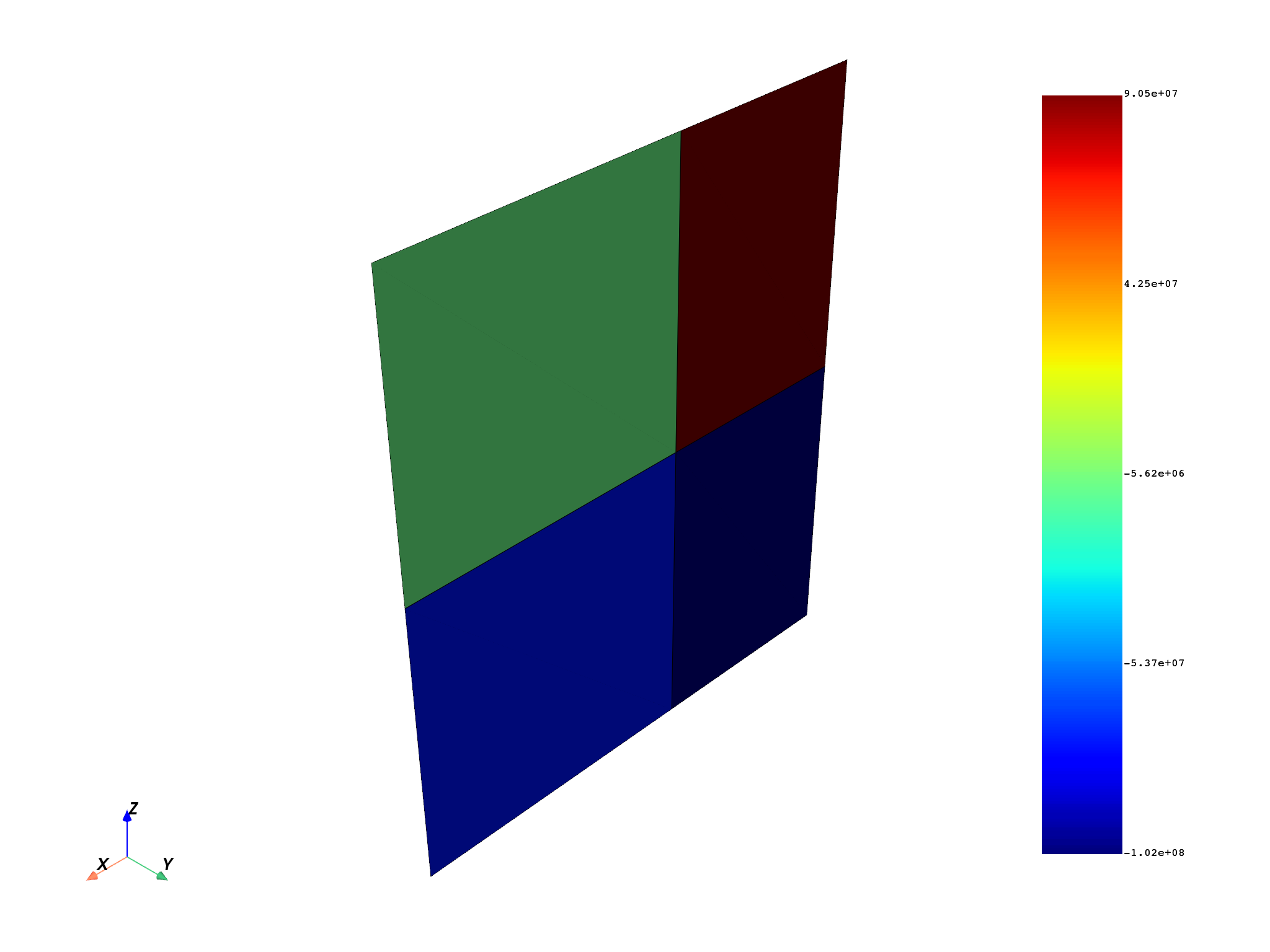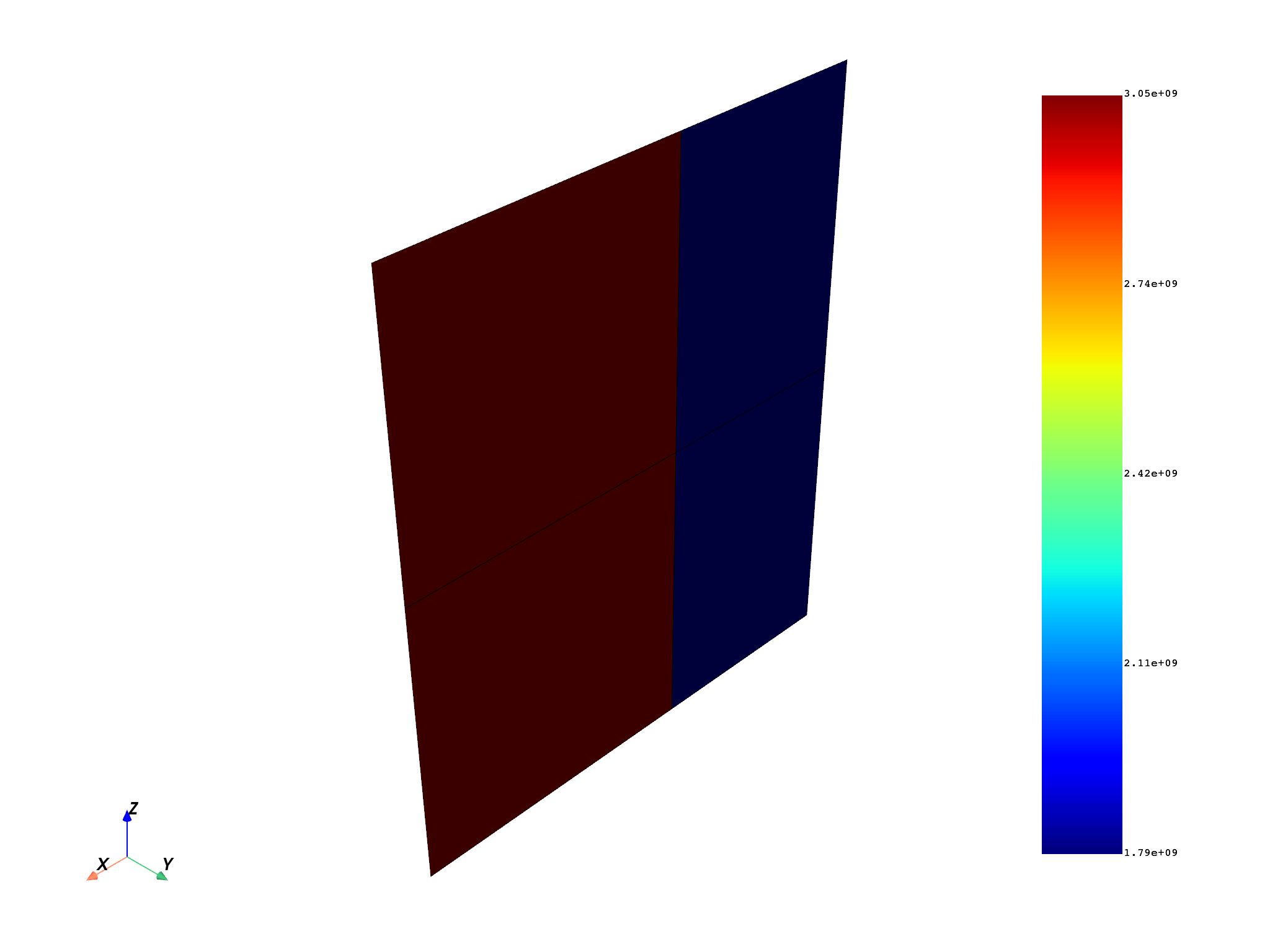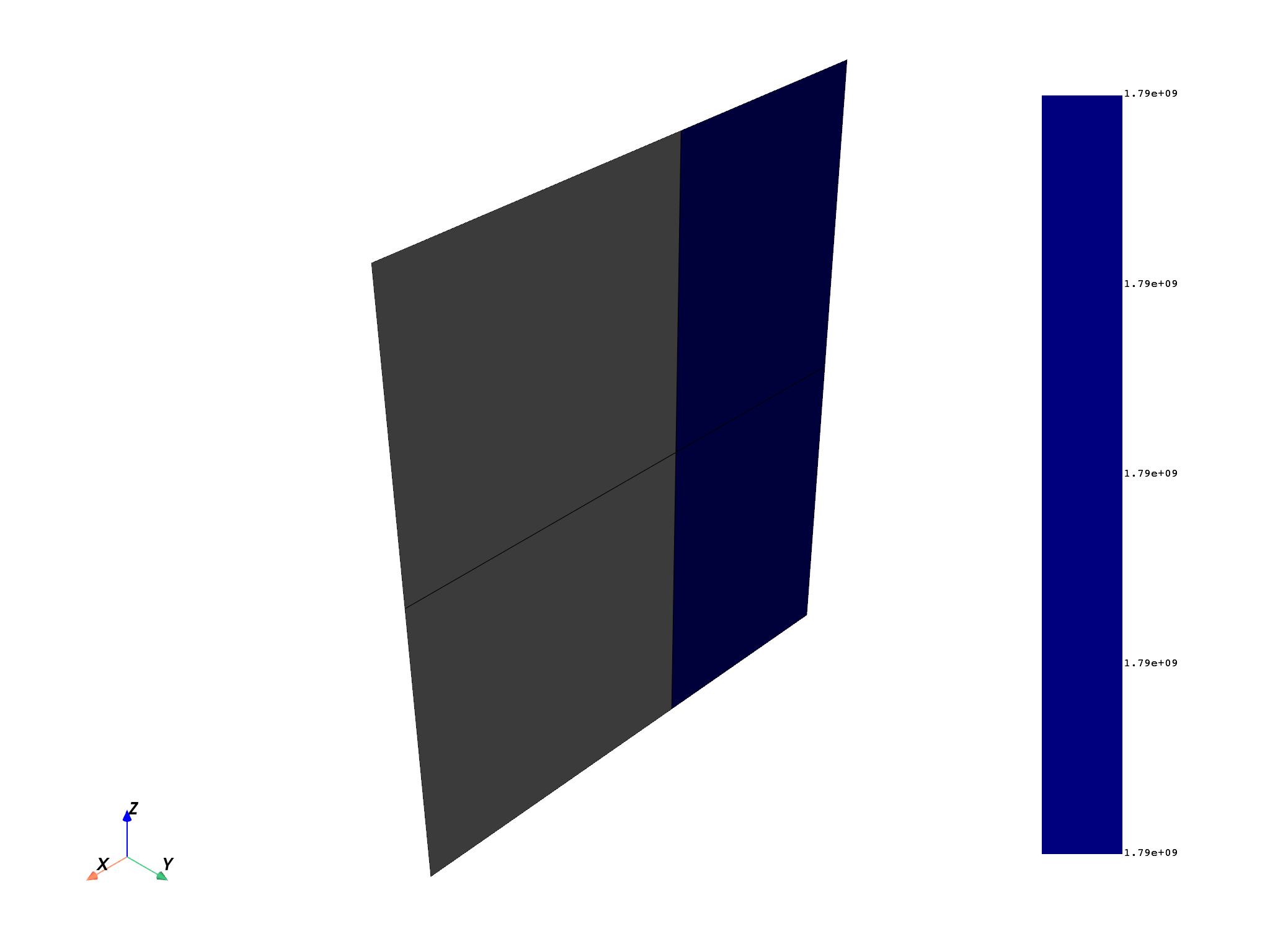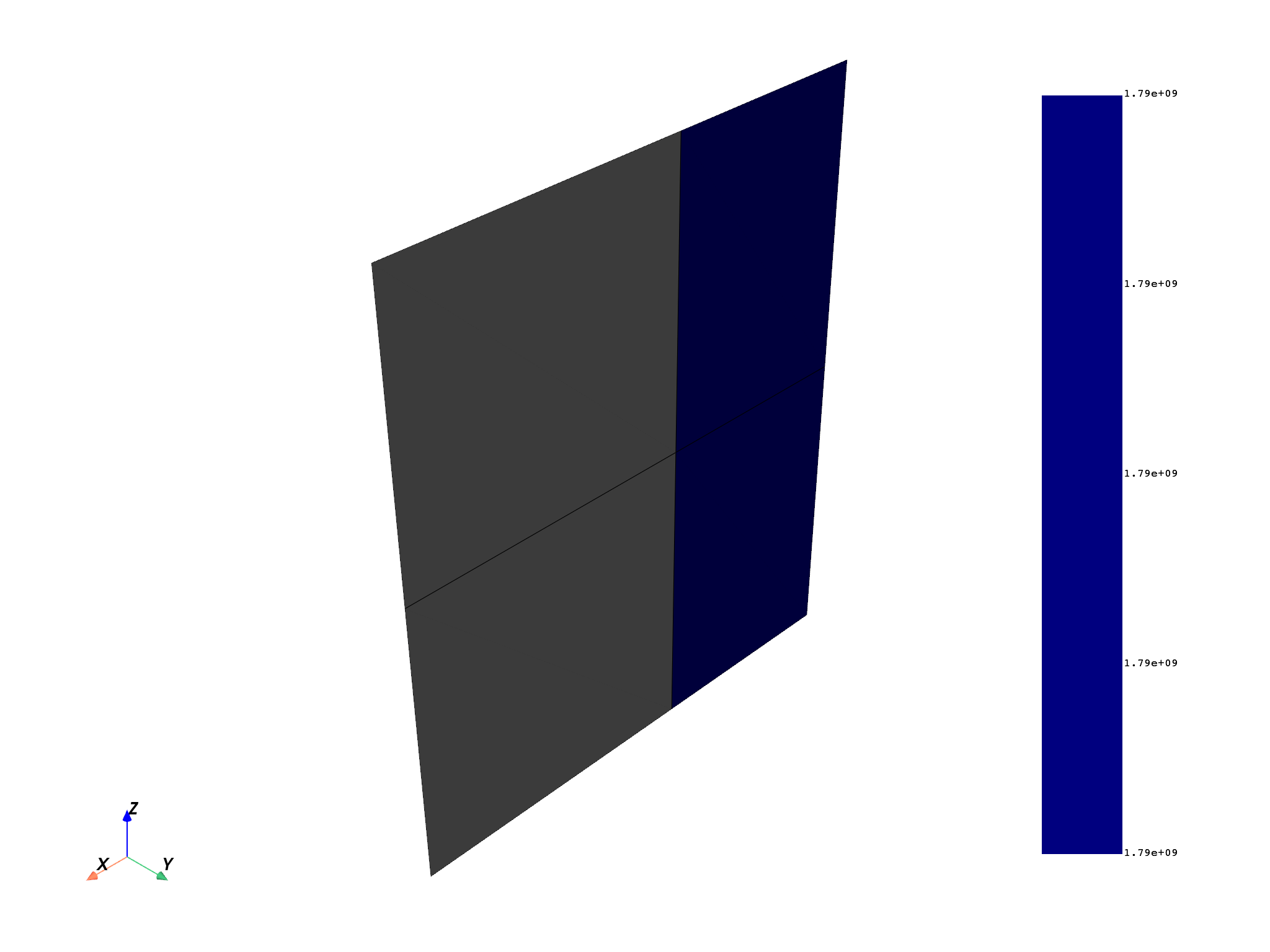Note
Go to the end to download the full example code.
Filter result data by different criteria#
This example shows how data filtering can be used for custom postprocessing of
layered composites. You can filter strains and stresses by material, layer, or
analysis ply. Filtering by analysis ply is implemented on the server side and
exposed with the get_ply_wise_data() function. In this case, the data is
filtered (and reduced) on the server side and only the resulting field is returned
to the client. This is the recommended way to filter data if possible.
For more complex filtering, the data is transferred to the client side and filtered
using numpy functionality.
The examples show filtering data by layer, spot, and node, as well as material
or analysis ply ID. To learn more about how layered result data is organized,
see Select elementary indices.
Note
When using a Workbench project,
use the composite_files_from_workbench_harmonic_analysis()
method to obtain the input files.
Set up analysis#
Setting up the analysis consists of importing dependencies, connecting to the DPF server, and retrieving the example files.
Import dependencies.
import ansys.dpf.core as dpf
import numpy as np
from ansys.dpf.composites.composite_model import CompositeModel
from ansys.dpf.composites.constants import Spot, Sym3x3TensorComponent
from ansys.dpf.composites.example_helper import get_continuous_fiber_example_files
from ansys.dpf.composites.layup_info import AnalysisPlyInfoProvider, get_all_analysis_ply_names
from ansys.dpf.composites.ply_wise_data import SpotReductionStrategy, get_ply_wise_data
from ansys.dpf.composites.select_indices import (
get_selected_indices,
get_selected_indices_by_analysis_ply,
get_selected_indices_by_dpf_material_ids,
)
from ansys.dpf.composites.server_helpers import connect_to_or_start_server, version_equal_or_later
Start a DPF server and copy the example files into the current working directory.
Set up model#
Set up the composite model.
composite_model = CompositeModel(composite_files_on_server, server)
Get result data#
Get the stress field. By default, the stress operator returns the stresses in global coordinates.
To get the stresses in the material coordinate system, the bool_rotate_to_global
input is set to False.
stress_operator = composite_model.core_model.results.stress()
stress_operator.inputs.bool_rotate_to_global(False)
stress_field_material_coord = stress_operator.get_output(
pin=0, output_type=dpf.types.fields_container
)[0]
Filter data by analysis ply#
List all available analysis plies.
all_ply_names = get_all_analysis_ply_names(composite_model.get_mesh())
all_ply_names
['P1L1__woven_45.2', 'P1L1__core', 'P1L1__ud', 'P1L1__ud_patch ns1', 'P1L1__woven_45', 'P1L1__ud.2']
The easiest way to filter data by analysis ply is to use the get_ply_wise_data() function.
This function supports different reduction strategies such as computing the average,
maximum, or minimum over the spot locations.
It also supports selecting a specific spot (TOP, MID, BOT) directly.
This example selects the maximum value over all spots for each node and then requests
the elemental location, which implies averaging over all nodes in an element.
Using the get_ply_wise_data() function has the advantage that all the averaging
and filtering is done on the server side.
if version_equal_or_later(server, "8.0"):
elemental_values = get_ply_wise_data(
field=stress_field_material_coord,
ply_name="P1L1__ud_patch ns1",
mesh=composite_model.get_mesh(),
component=Sym3x3TensorComponent.TENSOR11,
spot_reduction_strategy=SpotReductionStrategy.MAX,
requested_location=dpf.locations.elemental,
)
composite_model.get_mesh().plot(elemental_values)

The results can also be requested in global coordinates. This example gets the stress values in the global coordinate system, selects the top spot of a selected ply, and averages the values over neighbouring nodes to get nodal results.
stress_operator.inputs.bool_rotate_to_global(True)
stress_field_global_coord = stress_operator.get_output(
pin=0, output_type=dpf.types.fields_container
)[0]
if version_equal_or_later(server, "8.0"):
nodal_values = get_ply_wise_data(
field=stress_field_global_coord,
ply_name="P1L1__ud_patch ns1",
mesh=composite_model.get_mesh(),
component=Sym3x3TensorComponent.TENSOR11,
spot_reduction_strategy=SpotReductionStrategy.TOP,
requested_location=dpf.locations.nodal,
)
composite_model.get_mesh().plot(nodal_values)

Generic client-side filtering#
This example shows how to filter data by layer, spot, and node using the generic filtering on the client side. This code plots stress values in the material direction for the first node and top spot.
Get element information for all elements and show the first one as an example.
element_ids = stress_field_material_coord.scoping.ids
element_infos = [composite_model.get_element_info(element_id) for element_id in element_ids]
element_infos[0]
ElementInfo(id=np.int32(1), n_layers=np.int64(6), n_corner_nodes=np.int64(4), n_spots=3, is_layered=True, element_type=181, dpf_material_ids=array([3, 2, 2, 1, 2, 3]), is_shell=True, number_of_nodes_per_spot_plane=np.int64(4))
Get filtered data
component = Sym3x3TensorComponent.TENSOR11
result_field = dpf.field.Field(location=dpf.locations.elemental, nature=dpf.natures.scalar)
with result_field.as_local_field() as local_result_field:
element_ids = stress_field_material_coord.scoping.ids
for element_id in element_ids:
stress_data = stress_field_material_coord.get_entity_data_by_id(element_id)
element_info = composite_model.get_element_info(element_id)
assert element_info is not None
selected_indices = get_selected_indices(
element_info, layers=[element_info.n_layers - 1], nodes=[0], spots=[Spot.TOP]
)
value = stress_data[selected_indices][:, component]
# value needs to be passed as list because dpf does not support numpy
# slices in the append call.
local_result_field.append(value.tolist(), element_id)
composite_model.get_mesh().plot(result_field)

Filter by material#
Loop over all elements and get the maximum stress in the material direction for all plies that have a specific UD material.
ud_material_id = composite_model.material_names["Epoxy Carbon UD (230 GPa) Prepreg"]
component = Sym3x3TensorComponent.TENSOR11
material_result_field = dpf.field.Field(location=dpf.locations.elemental, nature=dpf.natures.scalar)
with material_result_field.as_local_field() as local_result_field:
element_ids = stress_field_material_coord.scoping.ids
for element_id in element_ids:
element_info = composite_model.get_element_info(element_id)
assert element_info is not None
if ud_material_id in element_info.dpf_material_ids:
stress_data = stress_field_material_coord.get_entity_data_by_id(element_id)
selected_indices = get_selected_indices_by_dpf_material_ids(
element_info, [ud_material_id]
)
value = np.max(stress_data[selected_indices][:, component])
local_result_field.append([value], element_id)
composite_model.get_mesh().plot(material_result_field)

Filter by analysis ply on the client side#
Loop over all elements that contain a given ply and plot the maximum stress value in the material direction in this ply.
component = Sym3x3TensorComponent.TENSOR11
analysis_ply_info_provider = AnalysisPlyInfoProvider(
mesh=composite_model.get_mesh(), name="P1L1__ud_patch ns1"
)
ply_result_field = dpf.field.Field(location=dpf.locations.elemental, nature=dpf.natures.scalar)
with ply_result_field.as_local_field() as local_result_field:
element_ids = analysis_ply_info_provider.property_field.scoping.ids
for element_id in element_ids:
stress_data = stress_field_material_coord.get_entity_data_by_id(element_id)
element_info = composite_model.get_element_info(element_id)
assert element_info is not None
selected_indices = get_selected_indices_by_analysis_ply(
analysis_ply_info_provider, element_info
)
value = np.max(stress_data[selected_indices][:, component])
local_result_field.append([value], element_id)
composite_model.get_mesh().plot(ply_result_field)

Total running time of the script: (0 minutes 4.694 seconds)

